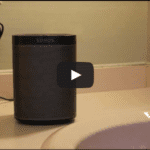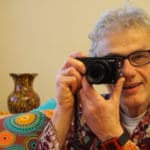I don’t think there’s a better value whole home streaming audio speaker than the Play:1 (C$219). Solo or in stereo pairs, the sound far exceeds the size and price. We have them all over the house. We play them individually, group them all together, we use them as an alarm clock and have programmed specific ones to play specific programs/stations at various times throughout the day – like Stanley Péan’s excellent “Quand le jazz est là” on icimusique in the kitchen at dinner time (or “l’heure de l’apéro” according to Stanley).
We play them loud, we play them soft and the sound is delightful. And I’ve never been less than pleased. Mostly they’re used for background music to accompany daily activities. As a result, I keep a smartphone or tablet nearby to change the volume and manage the playlist.
In November 2015, I had the opportunity to review the second generation Play:5 speaker – as detailed in the video.
What I can’t share in the video is a real listening experience. Let me try that in text.
Compared to the Play:1, the Play:5 has a distinctly larger and more open sound – the difference is immediate and apparent, but only when comparing the two back to back. There’s a spaciousness and presence that’s not part of the Play:1’s capability. Switching from one to other, no-one has difficulty telling the two apart. However, if I send the listener out of the room and then ask them to return a few minutes later, they have a great deal of difficulty deciding which is currently playing. Having listened to the Play:5s for a couple of weeks has not lessened my enjoyment of the Play:1s in any aspect – although clearly, space and budget permitting, it would be very nice to replace them all with Play:5s.
As I say in the video, I have several listening tracks.
Simone Dinnerstein J.S. Bach Goldberg Variations (Telarc CD 80692) Compressed files really don’t handle solo piano well – and the transition from the aria to the first variation is particularly ear-opening. I set the level so that the aria sounds like a piano in the room and wait for the fortissimo attack of the first variation. I was impressed that the Play:5s handle this challenge – the first time I’ve not been disappointed listening to this transition on a wireless system.
Antonio Forcione and Sabina Sciubba Meet Me in London (naim cd021 – sadly the only recording they made together). For a well-recorded voice play Caruso, for a terrific percussion and guitar track, play Brasilico. My reference to see how good these tracks sound, are at Bay Bloor Audio on the totem forest speakers. Sabina’s voice literally comes out of the speakers on the former, the snap of the drums is tight and powerful on the latter. Listening to Caruso on a high end playback system has brought tears to my eyes. Are the Play:5s as good as totem forest speakers through a Bryston amp (as I’ve auditoned these at Bay Bloor)? No. But on the Play:5s, it does sound as if Sabina is in the room as I expect, and Antonio’s guitar virtuosity is detailed and nuanced in a spacious room and free of artificiality – a pleasure to listen to.
Emilie-Claire Barlow Sings (RT CD0001) Pipoca creates an incredible blend between Emilie-Claire’s clean and pure voice and the band. The Play:5s keep the two separate and distinct. I’m not as familiar with her latest release (Clear Day) for comparative purposes, but following some extended listening I can highly recommend both the quality of the recording, which features a large orchestra playing Emilie-Claire’s novel, interesting arrangements and the ability of the Play:5s to fully deliver the complex and layered textures captured in this recording.
Lyle Lovett Joshua Judges Ruth (Curb MCAD 10475) The depth and breadth of the soundstage of the various players and singers in Church is the best cut I know for judging stereo placement, left to right and back to front. The Play:5s recreate this accurately, allowing me to position each vocalist while they’re singing, but also positioning each singer’s hand claps in precise definition.
Angelique Kidjo Djin Djin (razorandtie 79301822967-2) Although no recording can do justice to the power that Kidjo displays live, Gimme Shelter (with Joss Stone) does a pretty good job of raising the roof while opening your heart to the emotional power of this tune. Great bass, killer horns and searing vocals to challenge any system’s clarity when confronted with a wide-spectrum wall of sound. I cranked the Play:5s up LOUD for this. Admittedly, that’s not as much sound pressure as you’d have in a concert setting, but the bass is clean and punchy, the lower spectrum percussion is tight, the vocals maintain clarity through the power while the upper frequencies (to the extent I can still hear them at my age) are pure and clean. I find at high levels those frequencies can get crunchy, but not here.
My summary – the Play:5s stand up to extended and detailed listening, an opinion I would not have of any other wireless solution.
For Sonos, it’s all about the sound – they don’t provide specs for hifi nerds – no RMS watts, no frequency response graph, no THD. The products are deceptively simple – a brickless power cord, and the absolutely easiest setup and configuration I’ve experienced, although the new AppleTV comes close.
There are not many Sonos products. They offer three sizes of speaker (Play:1, Play:3, Play:5), a subwoofer, a soundbar and Connect, a device (with or without amp) to interconnect your home audio system, providing outputs from Sonos to the audio system and inputs to Sonos from other devices.
The one drawback of Sonos products – in the past you needed to have a “bridge” device directly connected via Ethernet – was eliminated this year. And the app keeps getting better – it now does a universal search across your library and all music supported services (Deezer, Rdio, Spotify, etc.) for artists, albums even individual tunes. So handy, so useful.
The video was shot on a Sony A6000 camera, using the Zeiss 16-70 lens, and the 30mm macro for closeups. Dual system audio recording on a Tascam DR-70D from a Sony ECM 44 mic. iPad screens recorded from Airplay to an Apple TV to an Atomos Ninja Star. As always, screen captures are edited and sometimes speeded up. Edited on Final Cut 10.2.2 on a 5K iMac.
As always, if there are any details I’ve overlooked, I welcome (and reply to) your comments and questions.




